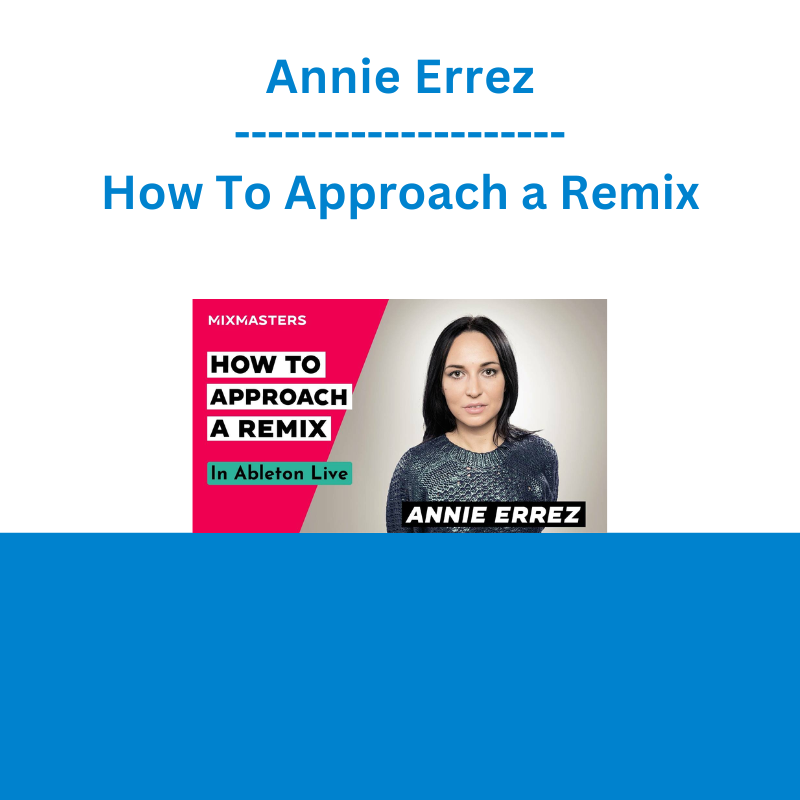*** Proof of Product ***
Exploring the Essential Features of “Annie Errez – How To Approach a Remix”
Course Contents
- Course Preview
- The Art of Remixing
- Original vs. Remix
- Remix Walkthrough
- Production Tips & Techniques
Live Q & A
- Q & A – 1
- Q & A – 2
Meet Your Teacher
Annie Errez
Annie Errez has been a DJ for well over 15 years, first gaining plaudits as a resident at Leeds’ famous Mint Club from 2008 until it closed down in 2019. Since being established as Mint’s go to warm up DJ, she has since played at nightclubs all over Europe.
Formerly rated as one of the 100 most underrated DJs by FACT Magazine, Annie’s dedication, graft and expertise means she is now a highly respected member within the electronic dance scene. Music production was a natural progression for Annie, and years of accumulating a deep and diverse record bag have helped her shape her own signature sound, resulting in a blend of deep, dark, tech and minimal house..
About This Course
In this course Annie will offer advice and her insight for how to remix another artist’s work.
She discusses the different stylistic approaches a producer can take when remixing, important things you need to be aware of when remixing, and offers ideas into how you can put your own spin on someone else’s track by deconstructing a remix she has been working on herself.
You will learn:
- The art of remixing…what is it?
- How to get the chance to remix a track
- The different ways to approach remixing music
- How to remix a track (guided walkthrough)
- Music production techniques to apply when reworking another artist’s track
- Tips for a successful remix
Lessons:
1. The Art of Remixing
How to remix a track… Annie begins by giving an overview of what is a remix, how to find a track to remix, what you should expect to receive in order to reproduce someone’s song. Annie also shares plenty of tips and advice that will make your remixing process much smoother.
- Introduction
- The Ethos of a Remix
- Things To Be Aware Of…
- Different Approaches to Remixing
- Feedback
2. Original vs. Remix
Analysing the original piece of music to understand how to approach remixing a track. Annie plays through the track from which her remix is based upon, and compares this with her reproduction.
- Original track playthrough
- Remix demonstration track playthrough
- Comparing the original with the remix
3. Remix Walkthrough
Annie now deconstructs a remix she is currently working on to show you how she would tackle a remix whilst putting her own sonic signature on the original. She breaks down the bass, pads, textures and vocals and explains how she has reworked each element for her remix.
- Remix walkthrough – Percussion
- Remix walkthrough – Retaining elements from the original
- Remix walkthrough – Bass
- Remix walkthrough – Pads
- Remix walkthrough – Textures
- Remix walkthrough – Vocals
- Remix walkthrough – Discards from original track
- Arranging the remix
4. How To Approach A Remix – Production Tips & Techniques
Useful music production techniques when working on a remix. Annie discusses layering percussive sounds, adding stereo width, using panning to create space in the mix, and how to blend two kick samples to create fatter and punchier kicks.
- Using RBass to fatten your kicks
- Layering kicks
- Panning
- Bass Analysis
- Using textures
5. Live Q&A Part 1
Annie answers questions on the best way to approach remixing another artist’s work. Questions include: is it normal for my remix sound appealing during the loop but not the arrangement stage, how to change the key of a vocal sample, and how long does a remix take to complete…
- For audio that is already processed do you tend to leave them as they are? If you add more, what processing do you add?
- How easy is it to change the key of a vocal if you do not like the original key of the vocal?
- How much time do you tend to need in order to make a remix?
- Is it common for a remix to sound good at the loop stage, but not at a later arrangement stage?
6. Live Q&A Part 2
Annie answers questions on how she approaches completing a remix.
Questions include: should layered kicks be the same pitch, what type of headphones and monitors does Annie produce on, and whether she utilises the Haas effect.
- When layering kicks does each sample have to be the same note?
- What monitors and headphones do you mix with?
- How did you add fill sections for this remix, or did you just use the fills from the original?
- Do you use the Haas effect with your claps? If so, how much panning and delay do you apply?
Please see the full list of alternative group-buy courses available here: https://lunacourse.com/shop/










 Sovereign Man Confidential - Renunciation Video
Sovereign Man Confidential - Renunciation Video  Fred Haug - Virtual Wholesaling Simplified
Fred Haug - Virtual Wholesaling Simplified  Racing Workshop - Complete Online Package
Racing Workshop - Complete Online Package  Erik Banks - Alternative Risk Transfer
Erik Banks - Alternative Risk Transfer  Chris Capre - Advanced Price Action Ongoing Training & Webinars
Chris Capre - Advanced Price Action Ongoing Training & Webinars  Julie Stoian & Cathy Olson - Launch Gorgeous - Funnel Gorgeous Bundle
Julie Stoian & Cathy Olson - Launch Gorgeous - Funnel Gorgeous Bundle  George Fontanills & Tom Gentile - Optionetics Wealth Without Worry Course
George Fontanills & Tom Gentile - Optionetics Wealth Without Worry Course  SMB - Options Training
SMB - Options Training  Trade Like Mike - The TLM Playbook 2022
Trade Like Mike - The TLM Playbook 2022